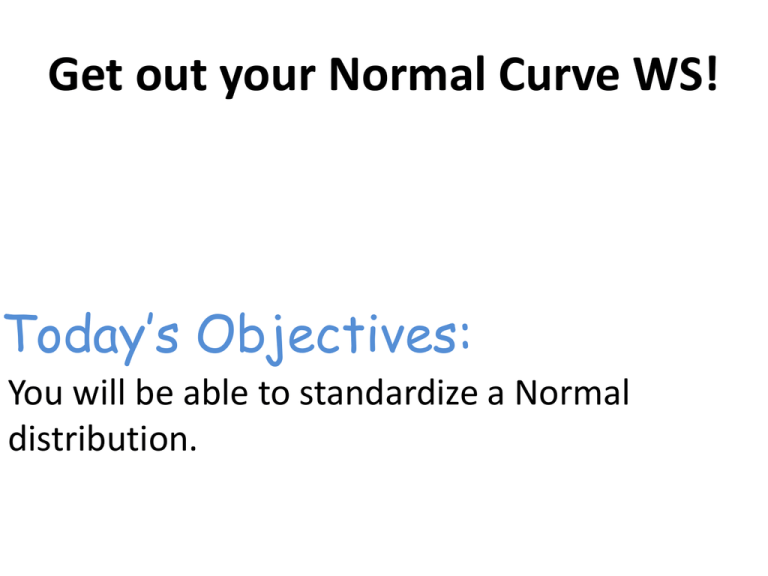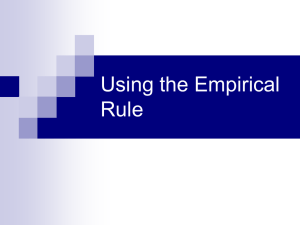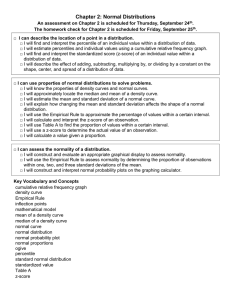standard deviations underneath the curve
advertisement

Get out your Normal Curve WS! Today’s Objectives: You will be able to standardize a Normal distribution. Warm Up Take a 3x5 Card from the front table and clear your desk of everything but a pencil. From memory, draw the Normal curve including all %’s inside the curve and the standard deviations underneath the curve. 13.5% 34% 34% 13.5% 2.4% 2.4% .1% 𝑥 − 3𝑆 𝑥 − 2𝑆 𝑥 − 1𝑆 𝑥 𝑥 + 1𝑆 𝑥 + 2𝑆 .1% 𝑥 + 3𝑆 Homework Check Homework Check Measurement Activity The big idea of this activity is that repeated measurements of the same quantity tend to follow a Normal distribution. You will produce your own data that will be displayed as a dot plot. Measurement Activity 1. Describe the shape, center, and spread of the distribution of measurements. Are there any outliers? 2. Calculate the average textbook length measurement for your class. Compare with the value provided by your teacher. Class Average: _________ Diener Value: _________ Z-Scores In Lesson 1 we learned the equation to find the z-score of a particular observation… 𝑥 − 𝑚𝑒𝑎𝑛 𝑧= 𝑠𝑡𝑎𝑛𝑑𝑎𝑟𝑑 𝑑𝑒𝑣𝑖𝑎𝑡𝑖𝑜𝑛 The usual notation for the mean of a density curve is 𝜇 (the Greek letter “mu”) and the standard deviation of a density curve as 𝜎 (the Greek letter “sigma”) Z-Score 𝜇 and 𝜎 are the same symbols we use to represent the mean and standard deviation of a population distribution. Z-Score Any time you are asked to standardize a Normal curve you must use the new equation using the new symbols, 𝑥−𝜇 𝑧= 𝜎 New symbols—Same meaning Standard Normal Distribution If the variable we standardize has a Normal distribution, then so does the new variable 𝑧. This new distribution is called the standard Normal distribution. Standard Normal Distribution The standard Normal distribution is the Normal distribution with mean 0 and standard deviation 1. Analyze The 68-95-99.8 rule tells us that about 68% of the observations fall within ±1 standard deviation of the mean. What if I wanted to find the percent of observations that fall between ±1.25? Does the rule help? Standard Normal Table All Normal distributions are the same when we standardize. Therefore we can find areas under any Normal curve from a table of values. Turn to the back of your book—Table A. Standard Normal Table Table A is a table of areas under the standard Normal curve. 𝑍 Example 1 Find the proportion of observations from the standard Normal distributions that are (a) Less than -1.25 Example 2 Find the proportion of observations from the standard Normal distributions that are (b) Greater than 0.81 CAUTION! A common mistake is to look up a z-value in Table A and report the entry corresponding to that z-value, regardless of whether the problem asks for the area to the left or to the right of that z-value! The table give you the area to the LEFT Example 3 Find the proportion of observations from the standard Normal distribution that are between -1.25 and 0.81. How to Solve From Table A, the area to the left of 0.81 is 0.7910 and the area to the left of -1.25 is 0.1056. So just subtract the values to find the answer. 0.81 -1.25 -1.25 0.81 Practice Questions Use Table A to answer the following questions. 1. 𝑧 is less than -0.37 2. 𝑧 is greater than -0.37 3. 𝑧 is less than 2.15 4. 𝑧 is greater than 2.15 You Try! Use Table A to answer the following questions. 1. 𝑧 is less than -1.58 2. 𝑧 is greater than -1.58 3. 𝑧 is greater than -0.46 4. 𝑧 is less than 0.93 Practice Questions Use Table A to answer the following questions. 1. 𝑧 is between -1.33 and 1.65 2. 𝑧 is between 0.50 and 1.79 You Try! Use Table A to answer the following questions. 1. 𝑧 is between -2.05 and 0.78 2. 𝑧 is between -1.11 and -0.32 Practice Questions-Backwards Use Table A to answer the following questions. Use the values in Table A that come closest to satisfying the condition. In each case sketch a standard Normal curve with your value of 𝒛 marked on the axis. 1. The 20th percentile of the standard normal distribution. 2. 45% of all observations are greater than 𝑧. You Try! Use Table A to answer the following questions. Use the values in Table A that come closest to satisfying the condition. In each case sketch a standard Normal curve with your value of 𝒛 marked on the axis. 1. The 63rd percentile of the standard Normal distribution. 2. 75% of all observations are greater than 𝑧. Homework Normal Distribution Worksheet Due Wednesday






